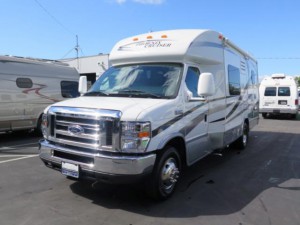Having your RV or motorhome sitting in storage all fall and winter can cause some unexpected things to occur.
Sealants and cracks can appear in places they hadn’t been before, tires can become low or flat, and batteries that were once fully charged can be now discharged. Depending on where you keep your motorhome, Mother Nature’s elements can have had their way with your vehicle in the form of rust or water system failures.
You may not be able to undo what has been done to your RV or motorhome during the past few months, but you can (and should) properly prepare it for your next big adventure!
Keeping a simple checklist of things to test before you hit the road can prevent you from running into a serious problem during your trip.
Check Your RV/Motorhome’s Water System
There are two important tasks to accomplish when “de-winterizing” your RV/motorhome’s water system:
- Flush the RV antifreeze from the plumbing system. If you use non-toxic RV antifreeze to protect the water system from freezing, you need to run fresh potable water through through the entire water system until all traces of the RV antifreeze are removed. After the plumbing system is flushed, you can take the water heater out of by-pass mode (if applicable). If the water heater wasn’t bypassed, the water heater tank is full of antifreeze and also needs to be drained and collected in buckets or other suitable containers.
- Sanitize the RV water system so it is safe to use. Make sure all of the drains are closed and any drain plugs are reinstalled. Here are step-by-step instructions on how to sanitize your water system:
- Take a quarter-cup of household bleach for every fifteen gallons of water your freshwater tank holds. Mix the bleach with water into a one-gallon container and pour the solution into the fresh water holding tank.
- Fill the freshwater holding tank completely full of potable water. Turn the water pump on and run water through all hot and cold faucets until you smell the bleach at each tap.
- Close the faucets and let the solution sit in the freshwater holding tank and water tanks for at least twelve hours.
- Drain all of the water and re-fill the freshwater tank with potable water. Turn the water pump on and open all faucets, running the water until you no longer smell any bleach.
- It may be necessary to repeat this process to eliminate all signs of bleach.
Check Your RV/Motorhome’s Batteries
Battery condition is dependent on how well the batteries were cared for during winter storage. When batteries are in storage, they lose a percentage of current through internal leakage. A battery can discharge up to 10% a month when its in storage. If you have checked and recharged the batteries while in storage, they should be ready to go. If not, the first step is to fully charge the batteries. After the battery is charged, add distilled water as required.
Check Your RV/Motorhome’s Tires
Just like the battery loses a percentage of its charge while being stored, your tires will lose pressure as well. RV or motorhome tires can lose two or more PSI a month sitting in storage. Using a quality tire inflation gauge, adjust the inflation pressure to the manufacturer’s recommended inflation pressure based on the load.
This is a great start to preparing your RV or motorhome for your next trip! Be sure to inspect your vehicle’s seams and sealants to ensure you’re ready to go.
Looking for a new or used RV, motorhome or conversion van? Classic Vans has a huge selection of quality vehicles perfect for your next road trip. Take a look at our inventory. Interested in low-cost nationwide van delivery? Contact us anytime.

